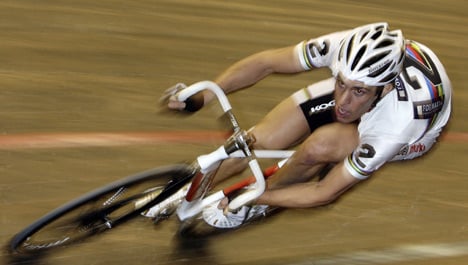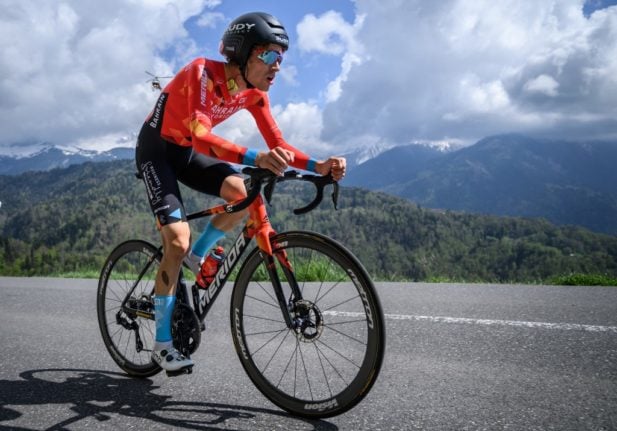Every winter, when most people store their bikes in the basement to wait for warmer weather, a sort of traveling cycling circus rolls across Europe.
From Amsterdam it heads to Ghent, Dortmund, Munich, Bremen, Stuttgart and eventually Berlin. In the German capital, packed crowds scream and whistle as cyclists whizz around an oval track at more than 50 kilometres an hour.
This year will be the 99th Berlin Six-Day Race. Even in cycling-mad Germany, six-day races are a dwindling tradition. But Berlin’s competition has a long and proud history.
Every year at the end of January, the six-day comes to the city’s velodrome. From opening night on Thursday to the finale on Wednesday, action on the track is almost constant, with everything from sprint duels to hair-raising multi-lap free-for-alls that get nearly all the riders out on the track at once.
“It’s fascinating to see how fast they go,” says Dieter Westphal, a Berliner who went to the race last year. “It’s just impressive how athletic it is.”
In the early days, two-man teams rode their bikes around a track 24 hours a day for six days, with one person on the track at all times. The winner was the one who finished the most laps. Today’s format is a little more spectator-friendly: 18 two-man teams compete in a dozen or more high-speed events a night, collecting points all week to determine the eventual winner.
The cycling feats are the biggest draw, but plenty of people come for the party too. On Friday and Saturday, the most popular nights of the event, racing lasts until after two in the morning – there’s even a halftime show at 11 pm. The atmosphere is part action-packed sporting event, part disco and part beery Volksfest.
Click here for a photo gallery of last year’s Six-Day Race.
But it’s no cheap night out: on Friday, tickets range from €52 for seats near the finish line to €30 for standing room spots in the infield and around the edge of the arena. The track itself is 250 metre wood oval. In the middle, a four-foot tall disco ball glitters above a VIP lounge, champagne bar and stands offering food and beer.
“It’s really a cross-section of society,” says Heinz Seesing, the head of the Berlin Six-Day organisation. “Fans come from all of Berlin, but in the former (communist) East cycling was always a big deal – that’s why we get so many visitors from former East Berlin. I haven’t experienced this kind of crowd anywhere else in Europe.”
For families, Sunday’s race is a great option: Racing starts at noon, with €35-family tickets available for parents and kids. “It’s our philosophy that kids are the visitors of tomorrow,” Seesing says. “They’ll always remember going to the race with dad and mum.”
Although there are six-day races in other cities, Berlin’s is the most prestigious and there have been more here than anywhere else in the world. Yet the event is actually an American import. A German cyclist organised the first race in Berlin in 1909 after a trip to New York’s Madison Square Garden, which first staged one in back in 1899.
In the wild Weimar Republic years, six-day races were one of the city’s most popular attractions, a chic see-and-be-seen event for the city’s artists, musicians and socialites. In the 1920s, Berlin often held three competitions a year.
But the golden age ended in 1934, when the Nazis shut the racing down. “In the disastrous Hitler era, the races were verboten,” says Seesing. The all-night party scene was too decadent, there were too many Jews involved, and the race’s seamy, beer-soaked image didn’t fit with Hitler’s ideal of sports as a character-building activity for “wholesome” German youth.
The competition came back to a divided Berlin in 1948; international pros raced in West Berlin, and an annual Winter Race was held for communist-bloc amateurs in the East. After the Wall came down in 1989, the reunited city eventually decided to build the flashy new velodrome that was ready for the 95th installment of the event.
The competition’s combination of history, action and alcohol make it welcome respite from the city’s dark and cold winter nights. For cycling fans, it’s a must. But you don’t need to be a hard-core gearhead to enjoy it – the curious will discover a unique Berlin sporting experience.
The Berlin Six-Day Race
January 28 – February 2
Paul-Heyse Str. 29 IV
10407 Berlin
Tel: 030 – 97 10 42 04



 Please whitelist us to continue reading.
Please whitelist us to continue reading.
Member comments